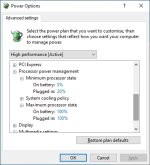None of those will be super energy-efficient.
The Haswell (4460) was badly impacted by Meltdown; it got a microcode patch, but that impaired its I/O speed by a bunch, so it's not a good server chip anymore.
The G620 is the generation after, Sandy Bridge, and would probably be reasonable as a server chip, but lacks many niceties like the AES New Instructions, which can come in very handy sometimes in utility boxes. It's only dual-core, but that would reduce its idle consumption.
The i5-6600 would be perfectly acceptable as a server chip, with the caveat that the idle power will not be as low as a modern one. It has AES and all of the virtualization extensions, so it should be a happy little server for you.
The Xeon would also be fine, but inferior. It's a generation older than the 6600, and doesn't clock very high. Most of the time you'd prefer the 6600, which clocks at close to twice the speed, has the same number of cores, and will be a little more efficient per core. And the 6600 will probably also idle substantially lower.
If your primary goal in setting up a new server is power efficiency, then probably the Raspberry Pi 4 would work well. If you want more I/O power, an RPi5 will burn like 5 more watts but give you substantially more bandwidth. But an RPi5, all in, will usually cost about $120, where you can get fully populated Intel N97 boxes for like $150, albeit with a shitty SSD that you probably won't want to keep.
Those N97 and N100 (slightly slower) boxes are omnipresent, and you can get them in all kinds of configs with different I/O setups. But then you have to know exactly what you want for I/O, and it sounds like maybe you don't.
So: I think I'd probably recommend starting with the I5-6600, if you have a motherboard and RAM for it. That will give you lots of I/O and connectivity, and doesn't cost anything. Get it set up and running, and learn what you want to do with it. Once you know what its actual day-to-day purpose is, then think about replacing it with a more efficient mini-PC, if you can find one that has enough I/O ports to do what you want.
An example: some mini-PCs come with external SFF-8087 ports to drive four SATA drives. That would be very useful for a NAS, but mostly useless if you don't need the storage. Once you know what you're doing with the machine, then you can sort through the many many options and maybe buy a more efficient CPU.
Or maybe not. Say the machine is 40W at idle; at 17 cents per KWh, you're talking $5.06 for a 30-day month. Going to a 20W idle would only save you $2.50ish a month, so it would take a long time for a more efficient machine to pay for itself.
If you live in an area with expensive power, like Hawaii, that could be very different. I'd be very concerned about idle power at the 50-ish cents that Hawaiians pay.

